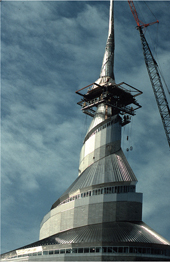What are Cold Rolled Finishes?
Cold rolled finishes apply to flat products such as sheet or coil, with thickness less than about 5mm and usually less than 3mm. They are firstly hot rolled into a strip (or cast into a slab which is hot rolled into a strip) and then cold rolled. Cold rolling reduces the thickness by at least 50%. This smooths the surface, refines the grain structure and causes differences in the mechanical properties along and across the rolling direction. In the case of austenitic and duplex alloys, the process hardens and strengthens the stainless steel. Finally, the steel is softened by annealing in a furnace? Each surface finish may undergo additional processes to improve the surface further. The smoother the surface finish is, the higher resistance to corrosion it will be.
These mill produced finishes must be handled carefully as surface damage such as scratches, grinding marks or spatter cannot be matched by polishing with abrasives or etching with chemicals. Of the 3 finishes, BA is most nearly able to be matched by a mirror polish.
Standards
The most common definitions of these surface finishes are provided by ASTM A480 and EN 10088. In both cases it is the cold rolled manufacturing method that is specified rather than specific, measurable characteristics about the surface. We have used ASTM A480 as an example:
ASTM A480:
No. 2D - A smooth, non-reflective cold-rolled annealed and pickled or descaled finish. This non-directional finish is favourable for the retention of lubricants in deep drawing applications.
No. 2B - A smooth, moderately reflective cold-rolled annealed and pickled or descaled finish typically produced by imparting a final light cold-rolled pass using [large diameter] polished rolls. This general-purpose finish is more readily polished than No 1 or 2D finishes. Product with 2B finish is normally supplied in the annealed plus lightly cold-rolled condition unless a tensile-rolled [harder and stronger] product is specified.
Bright Annealed [BA] Finish- A smooth, bright, reflective finish typically produced by cold rolling followed by annealing in a protective atmosphere so as to prevent oxidation and scaling during annealing.
2B
2B is the most widely used stainless steel surface finish. It is especially common in industrial, chemical and food processing applications such as process vessels and tanks. It is also used in some architectural applications that will not be closely examined for uniformity of finish such as downpipes and gutters.
When specifying this finish think about these attributes:
- 2B is the most economical finish
- It is highly corrosion resistant because it has been chemically pickled and is smooth
- Over broad areas and between batches etc., it is not uniform and may not match in appearance
- It has been produced in the mill and can't be matched after fabrication
- It if often protected by plastic films until final cleanup and commissioning
2D
2D is used around the world in applications where its low reflectivity is important. The largest application is in roofing materials. The surface is rougher than 2B and retains lubricants better making it appealing for deep drawring. 2D surfaces are not designed for appearance so the limitations on matching of weld and other surface damage is not as critical. Railcars are a typical example where thicker sheet and ongoing abrasive damage make the rougher 2D a suitable finish.
When specifying this finish think about these attributes:
- 2D is not commonly available in Australia
- It is highly corrosion resistant because it has been chemically pickled and is relatively smooth
- Over broad areas and between batches etc., it is not uniform and may not match
- It has been produced in the mill and can't be matched after fabrication
Bright Annealed (BA)
The classic use of a BA finish is domestic: the interior of a dishwasher or clothes washing machine. In the clothes washer, it also provides a smooth, non-abrasive surface for the clothes to slide around. The mirror like surface is also used in road mirrors where a precise image is not required.
When specifying this finish think about these attributes:
- BA is common in some grades and thicknesses, but not all
- It is highly corrosion resistant because it is very smooth
- Different batches may not match
- It is has been produced in the mill and can't be exactly matched after fabrication although a mechanical mirror polish can be close.
Post Production Processing to Improve Corrosion Resistance
All the cold rolled processes include a pickling stage. Pickling is the removal of high temperature scale and the adjacent low chromium layer of metal from the surface of stainless steel by chemical means. Pickling will also remove manganese sulphide inclusions and any other contamination on the surface. Pickling results in a very clean, highly corrosion resistant surface, but will slightly roughen the surface.
Differences Between Alloys
Most articles on finishes assume that standard grade austenitic stainless steel is used. Typically a highly corrosion resistant grade has a duller appearance than the same thickness material with a lower corrosion resistance. This illustrates the more aggressive measures required to remove oxide scale from a high alloy austenitic or duplex than a standard grade 304 or 316.
There is little data on finishes of ferritic grades but general observation shows that for comparable thickness and finishing processes, cold rolled 430 is brighter than 304. It is not known if this difference extends to comparisons between more highly alloyed grades.
This article featured in Australian Stainless Magazine - edition 38 Summer 2006